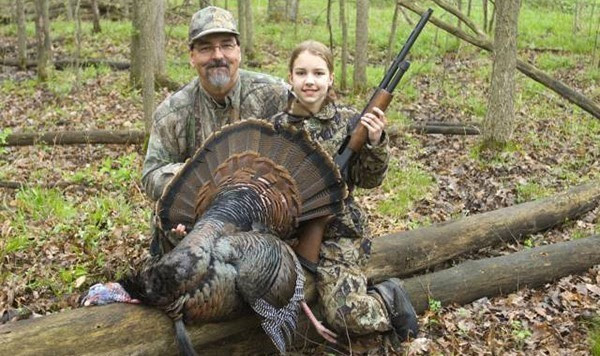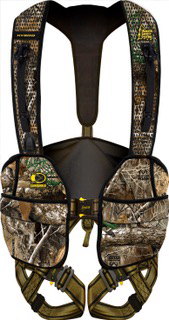Michigan spring turkey drawing results now available

Starting today, you can check your 2019 spring turkey application results by visiting Michigan.gov/Turkey. Read more
Outdoor commentary and legislative issues.


Starting today, you can check your 2019 spring turkey application results by visiting Michigan.gov/Turkey. Read more

DANVILLE, Ala. (March 4, 2019) — Hunter Safety System, in its continued effort to provide the most reliable and technologically advanced products to its customers, has redesigned its popular Hybrid and Ultra-Lite harnesses to make them even lighter and more comfortable. The new updated harnesses feature a new high-tech mesh material; the Hybrid sports the mesh material on the shoulder straps, while the Ultra-Lite utilizes the mesh on all material parts. Both harnesses are now 10-percent lighter than the previous models they are replacing.
Read more
By Glen Wunderlich
The month of February had a way of making us Michiganders forget about all that mild weather we received earlier in the winter season. Here in Mid-Michigan we may do our share of bellyaching about cold and snow but in comparison to our brethren in the Upper Peninsula, things don’t seem that bad. The latest report from Marquette County shows the snow totals for the season approaching 200 inches!
Having traveled through all parts of the U.P. on various hunts, the people always seemed helpful and friendly. Maybe it’s a result of togetherness developed by Yoopers fighting the elements. Or, maybe it’s the vastness of the open spaces and wilderness that actually has a way of bringing people together in times of need. One memorable excursion to the U.P. comes to mind supporting my theory.
After two successful deer hunting seasons in the far reaches of Iron County, friend, Fast Frank, and I planned a bear hunt for September, 1988. Part of the plan involved an old friend, Big John Stenvig,

Big John Stenvig, Big Alice (John’s wife) and Fast Frank (hat) cleaning fish from the Keweenaw Bay
who lived in Baraga, and had agreed to do some bear baiting before our arrival. Unfortunately, when we arrived at Big John’s door, we learned that he had passed away; we also learned no baiting had taken place and it was time for plan B – whatever that would involve.
Off to the local watering hole, where we sat to ponder the immediate future. While there, we met two local gents that offered to give us some bear bait – a necessary ingredient for a hunt. We followed them to their home, laughed it up a bit with the boys, and left with one large can of fish-smoking brine water. It was a start, but where we were to hunt was still a mystery.
Back at the Baraga tavern the mystery began to unfold, as we talked to a gentleman trucker who needed a ride home, because his 18 wheeler had broken down and was being serviced in Crystal Falls. The stranger, turned friend, said that if we were to take him home, he’d put us in some bear country.
Off we motored to the small town of Tapiola in the Keweenaw Peninsula with our new-found friend packed into the front seat of our 1971 Ford pickup camper.

1971 Ford Camper
As we rolled into town, our friend directed us to pull behind the local lodge, where he promptly used a key to open the back door of the empty building. Within minutes, people began to fill the room, including the mayor, who offered advice and shared tall tales. Sure was a friendly bunch.
We didn’t stay long, before our trucker friend had us following him along a desolate two-track road to Nowheresville. The trucker met his obligation and departed and we began exploring the area. Sure enough, there was plenty of bear sign – tracks and claw marks on trees right where we would camp.
After several days, that can of fish juice was gone and so were our hopes of taking a bear. Frank and I agreed to pull out but that ol’ truck wasn’t in a cooperative mood. We determined that we needed a new alternator, but there sure weren’t any in Nowheresville; we were just plain stuck! And, this was before cell phones had been attached to everyone.
Fortunately for us, however, our trucker friend knew we were short on bait and returned to our camp with some family members and a load of frozen meat they’d salvaged after cleaning out their freezer. Dang considerate of them, but our immediate concern was our lack of transportation. The trucker’s son mentioned that he had an old Ford truck at home and that he’d take the alternator from it and bring it to us. Imagine that!
A little while later he returned with the device and we fired up our vehicle. We had to repay the man, so we got directions to his house, purchased a new alternator in Houghton, replaced the donated alternator with the new one and then delivered and installed the donor unit in his truck.
By this time, we had had enough fun “bear hunting” and headed for home expecting never to see these friendly folks again. But, wouldn’t you know it, hours from Tapiola heading into Crystal Falls, we crossed paths with the trucker on US 41. Apparently, his rig had been repaired and he was driving it to his home in Tapiola, noticed our one-and-only camping rig and waved as he passed us traveling in the opposite direction. I waved back, too.
Most hunting trips are remembered for all the experiences apart from any trigger pulling; this was one of those I’ll never forget, because of the friendly folks of Michigan’s Upper Peninsula.
A long awaited package of provisions for sportsmen’s access and habitat conservation, the Natural Resources Management Act (S. 47) was advanced by the House of Representatives, and now heads to the President’s desk to be signed into law. A number of the provisions within S. 47 are access-oriented priorities of the Congressional Sportsmen’s Foundation (CSF).
Introduced in January by Congressional Sportsmen’s Caucus (CSC) Member Senator Lisa Murkowski (AK), S. 47 was passed by the U.S. Senate on an overwhelming bipartisan vote of 92 – 8, and most recently on a strong bipartisan vote of 363 – 62 in the U.S. House – all within the first two months of the 116th Congress. Priority provisions for CSF include:
“CSF applauds Congress for passing the Natural Resources Management Act early in the 116thCongress and ensuring that this bill did not fall to political gridlock as it has in past Congresses,” saidCSF President Jeff Crane. “S. 47 includes critical provisions to increase public access to hunting, angling, and recreational shooting and is truly a win for sportsmen and women across the country.”
Read more

The 2018 elk hunting season stats are in, and the 2019 winter elk survey just wrapped up, providing a clear picture of where Michigan’s elk population currently stands.
Hunt period 1, which targets elk outside of their traditional range, was 12 days long. From Aug. 28-31, Sept. 14-17 and Sept. 28-Oct. 1, 99 state hunters harvested 68 elk (28 bulls and 40 antlerless elk.) In addition, all three Pure Michigan Hunt winners were successful during the first hunt period.
During hunt period 2, Dec. 15-23, another 100 state hunters harvested 78 elk (30 bulls and 48 antlerless elk). All locations in the northern tip of the state are open to hunting for this later hunt.
In order for regulated hunting to assist in managing elk, Michigan’s elk population first must be evaluated.
“Our population goal for elk is between 500 and 900 animals. This has been determined as the best balance for the forests, area agriculture and residents,” Michigan Department of Natural Resources elk specialist Chad Stewart said. “Besides having an estimated population, knowing where they are located is also very important.” Read more

What began with a handful of classes at the Carl T. Johnson Hunting and Fishing Center in Cadillac, Michigan, has evolved into a statewide opportunity for in-depth learning about a variety of outdoor topics – from fly fishing to food plots to photography.
About 300 students participated in the DNR’s Outdoor Skills Academy during its first year in 2014. By 2018 that number had nearly doubled to almost 600 participants.
“Our classes offer more than just a brief taste of outdoor activities – we spend a full day or more teaching the needed skills to get out and try those activities,” said Ed Shaw, interpreter at the Carl T. Johnson Center and originator of the Outdoor Skills Academy. “We provide gear, hands-on experience and expert instructors.”
These instructors – also known as “pro staff” – are knowledgeable and proficient in the outdoor pursuits they teach. Among the upcoming classes, for example, are a whitetail food plot and habitat management clinic with staff from Killer Food Plots, a class on attracting butterflies with native plants taught by naturalist Craig Elston of CDE Nature, a walleye fishing clinic with professional anglers and a wildflower photography workshop by world-renowned photographer Tom Haxby.
Read more
By Glen Wunderlich
In Michigan’s hunting digest there are a handful of critters listed together for which there is no bag limit, the season never closes, and all that is needed is a valid Michigan small game license. Pound for pound, none is more destructive than the red squirrel or pine squirrel, as some call it. If you’ve ever had any of them in your attic or garage, you also know how difficult it is to keep them from their incessant, chewing ways. They can get through the smallest of openings, and if their entrances are blocked, they’ll simply chew their way around or through just about any barrier. Their habitual nature of constantly biting and chewing makes them the most destructive of the four Michigan species.
Red squirrels are about half the size of their cousins – the fox, gray, and black squirrels – and have a reddish brown color on their upper parts and cream or white colored under parts with white circles around their eyes. Their favored habitat is mature conifer trees, where they’ll strip conifer cones for the seeds within. Other items on the menu include bird eggs, young rabbits, acorns, berries and mushrooms.
Predators of the red squirrel are raccoons, foxes, weasels, bobcats, coyotes, minks, fishers, owls, hawks, martens – and humans. It’s easy to understand how a hawk or owl is able to snatch them from the heights of the tallest trees, but for any other animal with four legs to run them down in the treetops is simply amazing.
When hunting them in the woods, the best way to find them is to sit still and listen for their chattering sounds. They have a hard time being still for any prolonged time periods, so patience is the key to spotting them. Although they can be nearly impossible to shoot with anything but a shotgun while in motion, they’ll also make the mistake of facing off with humans and chattering for any and all wildlife to hear from a nearby perch; that’s the opportunity I look for with a .22 rimfire rifle

Four Red Squirrels Taken with a Ruger 10/22 and Lapua Sub-Sonic Ammo
I prefer subsonic ammunition, because it’s relatively quiet and accurate – which is extremely important when going after such small targets. One of my favorite firearms is an old Marlin model 81 bolt action produced in 1937 and topped with a 3×9 power Hawke Sport scope with parallax adjustment. I picked up the rifle for a song and found the trigger to be too poor for any good level of accuracy, so I had a qualified gunsmith massage the trigger a bit.
One brand of ammo that’s quite suitable around the home is CCI Quiet .22 ammo. It uses a 40-grain solid-lead bullet traveling at a scant 710 feet-per-second – well below the speed of typical sub-sonic .22 rimfire ammo. If you have a semi-automatic .22 rimfire rifle, this ammo will not cycle the action; single-shot, lever, or bolt guns are in order, if you choose this type of ammo. The parallax adjustment feature allows a shooter to focus as close as 30 feet and really comes in handy for up-close opportunities.
Squirrel season in Michigan closes March 1st, but again, red squirrel season is open year-round.
Washington, DC – The Senate approved the Natural Resources Management Act (S. 47), which contains many longstanding priorities advocated by the Congressional Sportsmen’s Foundation (CSF), on a bipartisan vote of 92 – 8.
Introduced by Energy and Natural Resources (ENR) Committee Chair and Congressional Sportsmen’s Caucus (CSC) Member Senator Lisa Murkowski (AK) along with Senator Maria Cantwell (WA), this comprehensive package of legislation includes numerous provisions that will improve access for sportsmen and women and will provide resources for habitat conservation programs. Following introduction in January, nearly 50 organizations submitted a support letter urging Senate Leadership to consider S. 47. Some of the priority sporting provisions in this bill include:
“The Congressional Sportsmen’s Foundation applauds the Senate Leadership for bringing this important legislation for sportsmen and women to the floor for a vote,” said CSF President Jeff Crane. “This is common sense legislation that is the result of years of negotiations with Congressional champions to get to this point, and CSF will work with the House of Representatives to pass this legislation and get it signed into law.” Read more
EDGEFIELD, S.C. — GoWild has partnered with the National Wild Turkey Federation to promote hunter recruitment with a sweepstakes valued at over $4,500.
One winner will receive an all-expense-paid turkey hunting trip for two to Wisconsin, where they will enjoy the full experience of chasing that morning thunder! The great team from Wolf Pack Adventures will guide the adventure.
“Few things are more exciting than hearing morning gobbles roll through the hills” said Brad Luttrell, Co-Founder and CEO of GoWild. “This sweepstakes and experience brings a chance to support the great conservation work done by the NWTF, and to take some personal responsibility for the future of hunting.”
By taking the NWTF & GoWild 2019 pledge, community members are committing to take someone hunting or fishing who has never gone before. The sweepstakes is open to any NWTF member — new or old. Sign up for a chance to win the Turkey Hunting Sweepstakes on the GoWild app (available on iTunes or Google Play). Entry is easy and free for members. Newcomers are encouraged to sign up and take the pledge with a friend.
Details & How to Enter for a Chance to Win*
*Terms and Conditions may apply. See complete details on GoWild. Read more

Anti-hunters fired blanks last month when they took verbal shots at Safari Club International and its Convention exhibitors in a media blitz, alleging that a new Nevada law had been violated.
“We are the good guys and through science-based conservation, we protect wildlife,” said SCI President Paul Babaz. “The antis only whine while hunters are out there in the wilds, protecting animals and fighting criminal poachers.”
In January 2019, representatives for anti-hunting groups gained entry into SCI’s membership-restricted annual Convention in Reno, NV for the purpose of exposing what they characterized as potentially illegal conduct by Convention exhibitors.
The anti-hunters publicized their findings, targeting SCI and several individual exhibitors. The accusers claimed that the exhibitors were selling items in violation of Nevada state law.
Not surprisingly, the accusers appear to have failed to properly research the law—or intentionally mischaracterized it–before publicizing their accusations. Also not surprisingly, the accusations were rebroadcasted by hundreds of internet communicators who similarly chose to skip the investigation that would have demonstrated the weakness of the accusations.
Nevada did pass a law that went into effect in 2018. N.R.S. 597.905 controls the sale of or possession with intent to sell products from shark fin, lions, elephant, rhinoceros, tiger, leopard, cheetah, jaguar, pangolin, sea turtle, ray, mammoth, narwhal, walrus or hippopotamus.
Read more